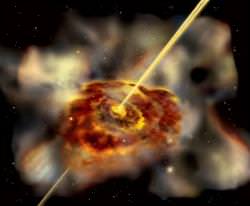Astronomers are now understanding the connection between supermassive black holes and the galaxies they inhabit better and better. In fact, it now looks like the powerful winds that blow out of these monsters can have a significant effect on the galaxies they inhabit, helping determine their growth.
In a recent study, published in the journal Nature, a group of scientists from the Rochester Institute of Technology report on their study of the rotating winds the rise up above the accretion disks surrounding supermassive black holes in distant galaxies.
With millions of times the mass of the Sun, supermassive black holes pull strongly at the material in their host galaxy. Just like water going down a drain, this material backs up into a swirling accretion disk. The material heats up, and blazes with radiation visible clear across the Universe – this is a quasar.
Astronomers from RIT and the University of Hertfordshire in England studied one quasar, PG 1700+518, located about 3 billion light-years from Earth. They were able to detect winds of gas coming off the accretion disk for the first time, both moving vertically away from the disk, but also rotating at the same speed.
This helps solve the long-standing mystery of how the accretion disk rids itself of angular momentum. It turns out, this wind needs to happen. If gas wasn’t being removed this way, material would stop falling in, and the quasar would turn off as the supermassive black hole was starved for fuel.
This wind both helps manage the growth of the black hole, but it also regulates the evolution of the galaxy. As the wind moves out into more distant regions of the galaxy, it helps collapse pockets of cold hydrogen, leading to regions of star formation.
Original Source: RIT News Release

